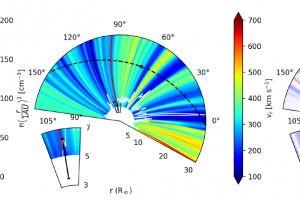A joint study Solar Orbiter / Parker Solar Probe of the solar wind. The paper: “Connecting Solar Orbiter remote-sensing observations and Parker Solar Probe in situ measurements with a numerical MHD reconstruction of the Parker spiral” of R. Biondo (UNIPA/INAF-OATo) recently appeared on A&A

Solar wind is made of charged particles (plasma) ejected by the coronal magnetic activity and travelling through the interplanetary space. Once these particles reach Earth and interact with the magnetosphere and atmosphere of our planet, they produce phenomena such as the aurorae.
In their journey through the interplanetary space, these particles are funelled by the solar magnetic field. Every study aimed at describing the solar wind and its impact on Earth magnetosphere must take into account that the outer solar magnetic field is dragged by the rotation of our star, assuming the shape of spirals (Parker spirals). Several space missions are dedicated to the study of these phenomena, which are typically described as “Space Weather” and which are of particular interest for their impact on Terrestrial activity. To study these phenomena, the NASA mission Parker Solar Probe reaches close distances to the Sun, performing measurements in situ of the solar corona up to 10 million km of distance. The joint NASA and ESA mission Solar Orbiter, instead, is equipped with insruments which observe the Sun from close distances. In particular, the Italian coronograph Metis is designed in order to observe the corona up to a few km of distance. Perform simultaneous observations with Metis and the Parker Solar Orbiter, the latter when it is close to the Sun, is not trivial, but it is important nevertheless since it allows to put observations into a unique scenario with accounts for the properties of the wind in regions million km far away each other.
The paper: “Connecting Solar Orbiter remote-sensing observations and Parker Solar Probe in situ measurements with a numerical MHD reconstruction of the Parker spiral” by the astronomer R. Biondo (University of Palermo and INAF – Astrophysical Observatory of Turin), recently appeared on the journal Astronomy & Astrophysics, presents the analysis of joint observations with Metis and the Parker Solar Orbit. The former observed active regions in the solar corona at 3-6 solar radii of distance, while the latter observed the wind at 21.5 solar radii of distance. The authors adopted the method called RIMAP, which provides analytical and numerical solutions of the magnetohydrodynamic equations, in order to reconstruct the structure of the Parker spirals and the wind. In this way, it was possible to succesfully connect the observations of the two instruments and derive several properties of the wind. For instance, it has been possible to verify the presence of fluxes with different densities and to measure the velocity of the wind which goes from 100 km/s to 700 km/s. Among the coauthors of the study, there are also P. Pagano and F. Reale of the University of Palermo, affiliated to INAF.
The figure (click here to visualize the entire image) shows an equatorial map of the density (left panel), radial velocity (central panel), and the intensity of the magnetic field (right panel) produced with RIMAP. The inner bounduray of each map corresponds to the region observed wiith the Parker Solar Probe from 15 to 21 January 2021. The black dashed line marks the trajectory of the probe projected onto the equatorial plane. The field lines connecting the regions observed with Metis and the Parker solar Probe are marked with a red line.
Mario Giuseppe Guarcello ( follow mguarce) ( youtube)
Follow the Astronomical Observatory of Palermo on Facebok
Subscribe the Youtube channel of the Astronomical Observatory of Palermo
